
Yun Baek-ha (Yun Sun), a calligraphic handscroll with part of the Buddhist Suranga Sūtra, Choson/Joseon dynasty, 18th century, from Korea (© The Trustees of the British Museum)
Calligraphy has always been regarded as one of the highest forms of art in East Asia. Poetry, calligraphy and painting were known as the ‘Three Treasures’ and upheld as virtuous activities for the scholar.
During the eighteenth century, calligraphy was dominated by Yun Sun (1680–1741) and his pupil Yi Kwang-sa. They both worked mostly in the style of the Chinese calligrapher Wang Xizhi (321 B.C.E.–79 C.E.). The calligraphy on this handscroll is a Buddhist sūtra. The fact that a Confucian scholar wrote out a Buddhist sūtra reflects the fact that Buddhism had survived despite the official disapproval of Buddhism by orthodox Confucians throughout the Choson/Joseon period (1392–1910).
At the end of the scroll, on the left-hand side, is a colophon in smaller calligraphy written by the foremost calligrapher of the nineteenth century, Sin Wi (1768–1845). Sin Wi was a statesman who served as Vice-Minister of Board of Rites and was an accomplished exponent of the ‘Three Treasures’.
This handscroll is an extremely valuable example of Korean calligraphy; there is even evidence that it belonged to the Choson royal family, in the partially-obliterated seal at the top right corner.
© The Trustees of the British Museum
Additional resources:
J. Portal, Korea – art and archaeology (London, The British Museum Press, 2000)

